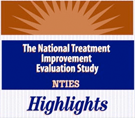For over 25 years Pat Moore Foundation has specialized in oxycodone and other opiate addiction treatment programs. We know first-hand the powerful addictive and destructive qualities of oxycodone and prescription drug abuse. Following is a short information guide on oxycodone abuse, addiction, symptoms, risks, hydrocodone, suboxone detox and treatment. We provide this as a service to Pat Moore Foundation family and friends, as well as for anyone seeking helpful and insightful information on oxycodone, including its addiction and abuse.
Appendix
 MethodologyNTIES sought to answer a number of questions fundamental to an understanding of treatment effectiveness and the quality of Federally-funded treatment programs. Some of the questions it sought to answer were:
MethodologyNTIES sought to answer a number of questions fundamental to an understanding of treatment effectiveness and the quality of Federally-funded treatment programs. Some of the questions it sought to answer were:
- How were grant funds used? What improvements were made as a result of these grants? How many and what types of clients were affected by the awards?
- Was the improvement approach validated? To what extent? What is the evidence that improved treatment services yielded effective results?
NTIES used a two-level study design. The first, or administrative level, covered the treatment orientation, size, budget, staffing distribution, and specific use of CSAT funds in all service delivery units eligible to receive support through the 157 grants, as reported by clinic directors. A second, or clinical-outcomes level, collected data when treatment began, ended, and approximately one year later from clients enrolled in eligible units.
In all, 6,593 clients at 78 selected service delivery units were successfully enrolled in the clinical outcomes study. Clients were interviewed at admission to treatment, when they left treatment, and then at follow-up 12 months after the end of treatment. More than 82 percent of the recruited sample completed the follow-up interview, and 4,411 of those are included in the outcome analysis.
The NTIES study, like many other major research surveys, relies primarily on self-reported data. Earlier methodological studies have shown this method of data collection to be generally valid and reliable. However, the NTIES study went a step further and collected additional data from outside sources to validate the self-reports in two key areas: illicit drug use and arrests. They collected a sample of drug testing data and a sample of arrest records that supported the NTIES findings.
Study Design
NTIES measured the outcomes of treatment primarily through a method known as a “before/after” or “pre/post” panel design. This method compares behaviors or other individual characteristics in the same research subjects, measured in similar ways before and after an intervention. The results are expressed as a percentage of the occurrence of a behavior or circumstance in the NTIES population during clearly defined equivalent periods of time before treatment and after treatment.
Source: http://ncadi.samhsa.gov/govstudy/f027/appen.aspx
Click here to return to the Index for the National Treatment Improvement Evaluation Study.
Pat Moore Foundation’s drug & alcohol detox and alcohol & drug addiction treatment programs are licensed and certified by The State of California. We provide non-medical and medically managed detoxification (using Suboxone, Subutex, and Buprenorphine when appropriate) and primary residential treatment. Our individual homes are on a unique co-ed campus where we offer gender specific treatment. We are located in Costa Mesa, in Orange County, Southern California, close to Newport Beach and Huntington Beach, and only an hour’s drive from Los Angeles and San Diego. To speak with a counselor, please call us 24-hours at (888) 426-6086 or if you’d like us to contact you, send a confidential message online by filling out our online form.
Note: All medical services are administered by medical professionals, which are facilitated and operated solely under the jurisdiction of a separate medical corporation.